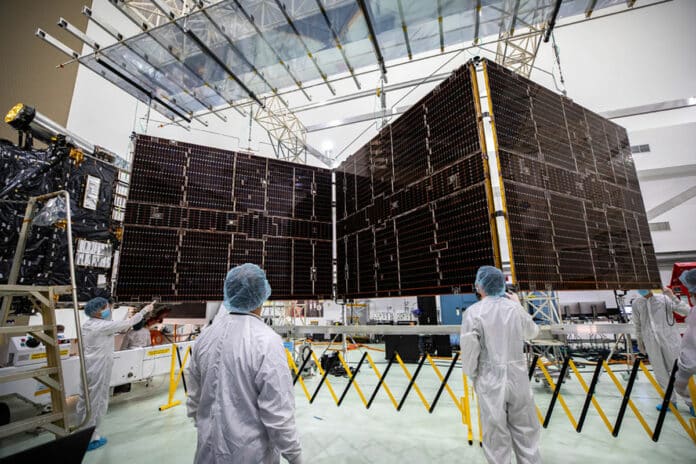NASA’s Psyche mission is speeding toward its launch date, preparing for the last of its launch-preparation milestones. The mission will explore a 140-mile-wide (225 kilometers) metallic asteroid called 16 Psyche.
The solar arrays for NASA’s Psyche mission underwent a final deployment test and were permanently installed on the spacecraft at Astrotech Space Operations near the agency’s Kennedy Space Center in Florida. Psyche is scheduled to launch no earlier than October 5, 2023.
Psyche is preparing for a 2.5 billion-mile (4 billion-kilometer) solar-powered trip to the metal-rich asteroid of the same name, which sits in the main asteroid belt between Mars and Jupiter. In a clean room at Astrotech, the solar arrays were attached to the spacecraft body, unfolded lengthwise, and then re-stowed.
After passing the deployment test, Psyche’s twin solar array wings were re-stowed and will remain tucked away on the sides of the orbiter until the spacecraft leaves Earth. At 800 square feet (75 square meters), the five-panel, cross-shaped solar arrays are the largest ever deployed at NASA’s Jet Propulsion Laboratory in California. With the arrays unfurled in flight, the spacecraft will be about the size of a singles tennis court.
When unfolded, each array is 37 feet (11.3 meters) long. The arrays will produce more than 20 kilowatts of power when the spacecraft is near Earth. However, they are primarily designed to work in the low light of deep space.
The asteroid Psyche is so far from the Sun that even these massive arrays will generate just over 2 kilowatts of power at that distance which is only a little more power than a hair dryer uses. But this is ample energy to meet Psyche’s electrical needs, including running science instruments, telecommunications, equipment that controls the orbiter’s temperature, and the spacecraft’s superefficient solar electric propulsion engines.
The system’s thrusters use electromagnetic fields to accelerate and push out charged atoms, or ions, of the neutral gas xenon. The expelled ions create the thrust that pushes Psyche through space and emits a blue glow. The spacecraft will accelerate to speeds of up to 124,000 mph (200,000 kph) relative to Earth during its interplanetary journey to the asteroid belt.
Psyche is scheduled to arrive at its destination in July 2029. The spacecraft will then orbit the asteroid for 26 months from various altitudes to gather imaging data and other measurements from the asteroid.
Scientists hope that understanding this asteroid, which may be part of a core of a planetesimal (a building block of a planet), will tell scientists more about planetary cores and Earth’s own formation.
